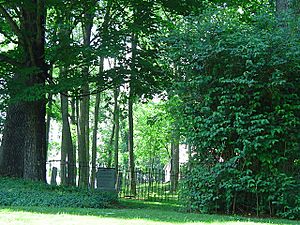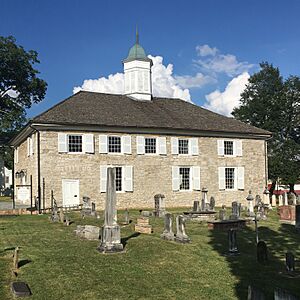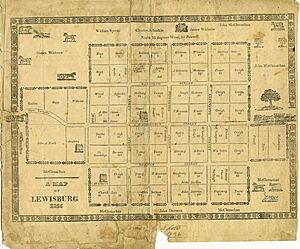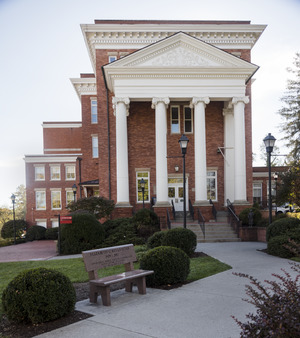Lewisburg, West Virginia facts for kids
Quick facts for kids
Lewisburg, West Virginia
|
|
|---|---|
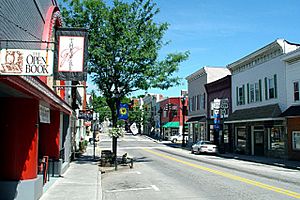
Downtown Lewisburg in Greenbrier County
|
|
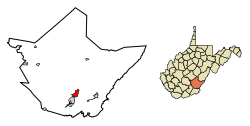
Location of Lewisburg in Greenbrier County, West Virginia.
|
|
| Country | United States |
| State | West Virginia |
| County | Greenbrier |
| Named for | Andrew Lewis |
| Area | |
| • Total | 3.81 sq mi (9.87 km2) |
| • Land | 3.80 sq mi (9.85 km2) |
| • Water | 0.01 sq mi (0.02 km2) |
| Elevation | 2,080 ft (630 m) |
| Population
(2020)
|
|
| • Total | 3,930 |
| • Estimate
(2021)
|
3,868 |
| • Density | 1,001.05/sq mi (386.48/km2) |
| Time zone | UTC-5 (Eastern (EST)) |
| • Summer (DST) | UTC-4 (EDT) |
| ZIP code |
24901
|
| Area code(s) | 304 |
| FIPS code | 54-46636 |
| GNIS feature ID | 1541811 |
Lewisburg is a city in Greenbrier County, West Virginia, United States. It is also the county seat, which means it's where the county government is located. In 2020, about 3,930 people lived there.
Contents
Lewisburg's Early History
Lewisburg is named after Andrew Lewis. In 1751, he was a young surveyor. He set up a camp near a spring, which is now called Lewis Spring.
In 1763, during Pontiac's Rebellion, Native Americans destroyed two early settlements in Greenbrier County. They killed the men and took women and children. This event removed most of the first settlers. The Native Americans were mainly Shawnees. Some stories say their leader was Hokoleskwa, also known as Cornstalk.
By 1770, a strong camp called Fort Savannah was built at Lewis Spring. In 1774, Governor Dunmore of Virginia asked Colonel Andrew Lewis to gather men. They were to fight Native American forces attacking the Greenbrier Valley. This conflict became known as Lord Dunmore's War.
Over 1,490 men gathered for this war. Some met at Fort Pitt (now Pittsburgh). Others met at Fort Union, where Lewisburg is today. Lewis's army marched to the Ohio River. They planned to enter the Ohio Country, home of the Shawnee. Cornstalk led the Native Americans. They tried to stop Lewis's army at the mouth of the Kanawha River. They fought a battle known as the Battle of Point Pleasant.
Founding and Growth of Lewisburg
The town of Lewisburg was officially planned in 1780. Matthew Arbuckle, Sr. was the first settler. Col. John Stuart was one of Lewisburg's first leaders. He was a commander in the Revolutionary War. He is known as the "Father of Greenbrier County." Stuart gave the land for the first county courthouse and the Old Stone Church.
Lewisburg was officially created in 1782 by the Virginia General Assembly. The first leaders were Samuel Lewis, James Reid, Samuel Brown, Andrew Donnelly, John Stuart, and Archer Mathews.
Courts from Virginia met in Lewisburg. This helped people living west of the mountains. Patrick Henry once successfully defended a client accused of murder here. The town and nearby farms grew. Many spas and resort hotels opened at the local mineral springs.
Lewisburg During the Civil War
During the American Civil War, several battles took place in and around Lewisburg. One important battle was the Battle of Lewisburg in 1862. Many buildings in town were used as hospitals and barracks by both sides. You can still see bullet marks on some buildings today. The Virginia Supreme Court library, which was in Lewisburg, was used as a hospital. It has a wall section with soldiers' graffiti.
Summer Camps and Historic Recognition
In the mid-1900s, Lewisburg had several children's summer camps. Camp Ann Bailey, a Girl Scout camp, was on the Greenbrier River. It was one of the first camps to allow all races in the 1950s. This happened thanks to Elizabeth Harden Gilmore, a civil rights activist. The camp operated from 1927 to 1974. It closed for the building of Interstate 64.
A boys' camp, Camp Shaw-Mi-Del-Eca, also opened on the river in 1929. These camps sometimes held joint activities, like dances, with Camp Alleghany, another nearby girls' camp.
In 1978, a 236-acre (0.96 km2) area in Lewisburg became a National Register Historic District. This means it's recognized for its important history.
Today, Lewisburg is home to the West Virginia School of Osteopathic Medicine. This is one of the medical schools in West Virginia.
Lewisburg's Geography
Lewisburg is located about one mile north of the Greenbrier River. The city covers about 3.81 square miles (9.87 km2). Most of this area is land. The area has many sinkholes because of its karst geology. A sinkhole is a hole in the ground that forms when bedrock dissolves.
Lewisburg is part of the Southern West Virginia region.
Climate in Lewisburg
Lewisburg has a climate with hot, humid summers. Winters are generally cold. This type of climate is called a humid continental climate.
| Climate data for Lewisburg 3N, West Virginia (37°51′24″N 80°24′15″W / 37.8566°N 80.4042°W, 2,300 ft or 701 m AMSL), 1991–2020 normals, extremes 1900–present | |||||||||||||
|---|---|---|---|---|---|---|---|---|---|---|---|---|---|
| Month | Jan | Feb | Mar | Apr | May | Jun | Jul | Aug | Sep | Oct | Nov | Dec | Year |
| Record high °F (°C) | 75 (24) |
77 (25) |
86 (30) |
91 (33) |
92 (33) |
99 (37) |
102 (39) |
97 (36) |
97 (36) |
94 (34) |
80 (27) |
75 (24) |
102 (39) |
| Mean maximum °F (°C) | 61.5 (16.4) |
64.3 (17.9) |
73.0 (22.8) |
81.6 (27.6) |
85.5 (29.7) |
88.4 (31.3) |
90.0 (32.2) |
88.9 (31.6) |
86.3 (30.2) |
79.5 (26.4) |
71.2 (21.8) |
62.1 (16.7) |
91.0 (32.8) |
| Mean daily maximum °F (°C) | 38.7 (3.7) |
42.9 (6.1) |
51.7 (10.9) |
63.8 (17.7) |
72.0 (22.2) |
78.9 (26.1) |
82.4 (28.0) |
81.1 (27.3) |
75.5 (24.2) |
64.7 (18.2) |
52.7 (11.5) |
42.3 (5.7) |
62.2 (16.8) |
| Daily mean °F (°C) | 29.3 (−1.5) |
32.3 (0.2) |
39.9 (4.4) |
50.7 (10.4) |
59.8 (15.4) |
67.3 (19.6) |
71.0 (21.7) |
69.6 (20.9) |
63.3 (17.4) |
51.9 (11.1) |
40.7 (4.8) |
32.9 (0.5) |
50.7 (10.4) |
| Mean daily minimum °F (°C) | 19.9 (−6.7) |
21.7 (−5.7) |
28.0 (−2.2) |
37.5 (3.1) |
47.5 (8.6) |
55.7 (13.2) |
59.6 (15.3) |
58.1 (14.5) |
51.1 (10.6) |
39.2 (4.0) |
28.8 (−1.8) |
23.6 (−4.7) |
39.2 (4.0) |
| Mean minimum °F (°C) | −0.1 (−17.8) |
3.6 (−15.8) |
10.8 (−11.8) |
22.0 (−5.6) |
31.3 (−0.4) |
41.9 (5.5) |
49.1 (9.5) |
47.7 (8.7) |
36.0 (2.2) |
23.5 (−4.7) |
14.3 (−9.8) |
5.8 (−14.6) |
−3.5 (−19.7) |
| Record low °F (°C) | −20 (−29) |
−10 (−23) |
−7 (−22) |
7 (−14) |
22 (−6) |
30 (−1) |
35 (2) |
35 (2) |
24 (−4) |
10 (−12) |
−1 (−18) |
−37 (−38) |
−37 (−38) |
| Average precipitation inches (mm) | 3.15 (80) |
2.87 (73) |
3.71 (94) |
3.85 (98) |
4.48 (114) |
4.06 (103) |
3.84 (98) |
3.43 (87) |
3.49 (89) |
2.59 (66) |
2.51 (64) |
3.48 (88) |
41.46 (1,053) |
| Average snowfall inches (cm) | 8.4 (21) |
8.7 (22) |
5.4 (14) |
0.6 (1.5) |
0.0 (0.0) |
0.0 (0.0) |
0.0 (0.0) |
0.0 (0.0) |
0.0 (0.0) |
0.3 (0.76) |
0.7 (1.8) |
5.4 (14) |
29.5 (75) |
| Average precipitation days (≥ 0.01 in) | 13.8 | 11.8 | 13.2 | 13.0 | 14.3 | 13.5 | 12.9 | 11.8 | 9.4 | 9.9 | 9.8 | 12.8 | 146.2 |
| Average snowy days (≥ 0.1 in) | 4.1 | 3.5 | 2.1 | 0.3 | 0.0 | 0.0 | 0.0 | 0.0 | 0.0 | 0.1 | 0.5 | 2.8 | 13.4 |
| Source: NOAA | |||||||||||||
Lewisburg's Population
| Historical population | |||
|---|---|---|---|
| Census | Pop. | %± | |
| 1860 | 969 | — | |
| 1870 | 875 | −9.7% | |
| 1880 | 985 | 12.6% | |
| 1890 | 1,016 | 3.1% | |
| 1900 | 872 | −14.2% | |
| 1910 | 803 | −7.9% | |
| 1920 | 1,202 | 49.7% | |
| 1930 | 1,293 | 7.6% | |
| 1940 | 1,466 | 13.4% | |
| 1950 | 2,192 | 49.5% | |
| 1960 | 2,259 | 3.1% | |
| 1970 | 2,407 | 6.6% | |
| 1980 | 3,065 | 27.3% | |
| 1990 | 3,598 | 17.4% | |
| 2000 | 3,624 | 0.7% | |
| 2010 | 3,830 | 5.7% | |
| 2020 | 3,930 | 2.6% | |
| 2021 (est.) | 3,868 | 1.0% | |
| U.S. Decennial Census | |||
In 2010, there were 3,830 people living in Lewisburg. There were 1,892 households. About 989 families lived in the city. The city had about 1,008 people per square mile (389 per km2).
Most people living in Lewisburg were White (90.5%). About 5.4% were African American. A small number were Native American (0.3%) or Asian (1.9%). About 1.6% of the population was Hispanic or Latino.
The average age in Lewisburg was 46.1 years old. About 17.7% of residents were under 18. About 24.1% were 65 or older. The population was 46.6% male and 53.4% female.
Arts and Culture in Lewisburg
In 1902, Andrew Carnegie built Carnegie Hall in Lewisburg. It was first a classroom building for the Lewisburg Female Institute. Today, it is a non-profit arts and education center. It serves over 75,000 people each year. It hosts live performances, art programs, classes, and art exhibits. Carnegie Hall in Lewisburg is one of only four Carnegie Halls still in use in the world.
The Greenbrier Historical Society and North House Museum collects and shares the history of the Greenbrier Valley. The North House was built in 1820. It was once a home and then an inn. Later, it was the President's home for Greenbrier Women's College. Today, the museum shows items from the Greenbrier Valley. These include a training saddle for General Robert E. Lee's horse, Traveller. There are also Civil War items and furniture made by local artists. The museum also has a research archive.
The Lewisburg post office has a special mural. It's called Old Time Camp Meeting. Artist Robert F. Gates painted it as part of President Franklin Roosevelt's New Deal. The mural shows a religious camp meeting. It is thought to be based on a local place called Brushy Ridge.
The Lost World Caverns are nearby. You can take self-guided tours and see many rock formations. Organ Cave is also in the area.
The State Fair of West Virginia happens every August in nearby Fairlea.
Lewisburg hosts West Virginia's largest Martin Luther King Jr. Day celebration. This event includes a march through downtown Lewisburg. There is also a community lunch and a program to honor Dr. King.
Belsnickle or Old Christmas is celebrated with the Shanghai Parade on New Year's Day. People dress in costumes and march down the main street. The parade has been happening for over 150 years. The name "Shanghai" comes from an old word about making a lot of noise.
Other yearly events include two food festivals. These are Taste of Our Towns (TOOT) in October and the Chocolate Festival in April. The Lewisburg Literary Festival celebrates books and writing in August. Famous authors and speakers have attended this festival. In 2013, musicians started the West Virginia Winter Music Festival. It helps musicians who need financial support.
The Greenbrier Classic Concert series takes place in nearby Fairlea. It happens at the State Fair Grounds every July. Many famous artists have performed there.
Transportation in Lewisburg
Historic Lewisburg is located where two main roads meet. These are U.S. Route 60, also called The Midland Trail, and U.S. Route 219. Interstate 64 also crosses U.S. Route 219 near town. This has led to new businesses growing in that area.
The Greenbrier Valley Airport supports many private planes. It also has daily flights to Charlotte, North Carolina, on Contour Airlines.
Notable People from Lewisburg
- Cleve Benedict – A former congressman and West Virginia Commissioner of Agriculture.
- Pinckney Benedict – A novelist and writer of short stories. He is Cleve Benedict's son.
- Phillip Hamman – A soldier and scout known as "The Savior of the Greenbrier."
- Brad Hoylman (born 1965) - A New York State Senator.
- Jim Justice – The current Governor of West Virginia.
- Robert Bruce King – A Circuit Judge for the U.S. Court of Appeals.
- Gary W. Martini – A Marine who received the Medal of Honor for his service in the Vietnam War. A local bridge is named after him.
- Henry M. Mathews – A former Governor of West Virginia.
- Stuart Margolin - An actor and director, famous for his work on The Rockford Files.
- Johnny Olson – An announcer, known for shows like What's My Line? and The Price is Right.
- Mason Patrick – A United States Army general.
- Colonel John Stuart – A pioneer and soldier, known as the "Father of Greenbrier County."
See also
 In Spanish: Lewisburg (Virginia Occidental) para niños
In Spanish: Lewisburg (Virginia Occidental) para niños


